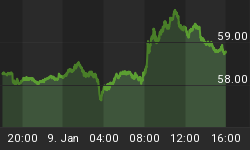In this week's talk with National Numismatics' Tom Cloud, he explains why the reported price of gold is not the real price.
DollarCollapse: Hi Tom. It's been a brutal couple of weeks in precious metals. Last time we talked you said that gold could fall to $1,540. Your prediction is close to coming true today, with gold below $1,560. What are your charts saying now?
Tom Cloud: There's serious support at $1,540, but if that doesn't hold the next major support level is $1,380. I don't see it going this low for a variety of reasons, but it is possible because when you have an asset that's gone up for 12 straight years you need a pullback to shake out the weak hands.
DC: You mentioned that there are a variety of reasons that a drop into the $1,300s is unlikely. Could you give us some of them?
TC: First, China is still an aggressive buyer. It's trying to build its gold reserves up to US levels (though who knows whether the US really has what it claims) and is a long way from that point, so presumably it would use a big correction to buy even more, which would moderate the drop.
From there the list is all over the place. Obama and Netanyahu [Israel's Prime Minister] just met to discuss Iran's nuclear weapons program. It's highly unlikely that they'll allow Iran to deploy nukes, so there could be more trouble in the Middle East soon.
The US kicked the debt ceiling thing down the road until September and now we're just printing money with no restraint. This is functionally the same thing as raising the debt ceiling; they just didn't call it that. You're talking $300-$400 billion of new debt in the next five months, and historically the gold price has tracked the debt ceiling.
And finally then there's seasonality. Historically the last four months of the year have accounted for 2/3 of each year's profits. So the further we get into 2013 the more support precious metals prices are likely to see.
DC: What about the latest European banking crisis?
TC: Cyprus is potentially huge. The Laiki bank just announced that they'll take 80% of their largest depositors' money, while the Bank of Cyprus' large depositors will lose 50%. This sends a message to people with uninsured deposits everywhere, and a large number of my calls this week have been people moving money out of banks and into precious metals because they were over the [deposit insurance] limit. But it's not just large depositors who should worry. The FDIC only has capital equal to 5% of deposits. So if there's a run on US banks even small depositors could see a haircut. This makes physical precious metals look relatively attractive.
DC: You'd think this would send gold through the roof...
TC: Part of the reason that it hasn't yet is that the dollar benefits from turmoil in the eurozone banking system, and a strong dollar equals a lower gold price. But that's not sustainable. Two of my biggest clients are exporters who say their business is off because the US goods they're selling are getting more expensive as the dollar goes up. So a strong dollar also means a weak economy, which the government can't accept.
DC: Is your order flow reflecting the weakness in metals prices?
TC: Just the opposite. Nobody's selling and big customers are buying. We're doing about 35 fewer sales per week but are selling more metal because the average order is a lot bigger. Meanwhile, premiums are rising and delays are lengthening. It takes two weeks or more to fill orders for silver maple leafs and a lot of other coins. Outside of the fall of 2008 and the spring of 1980 I've never seen physical supplies this tight.
DC: How can tight physical supplies co-exist with falling prices?
TC: There's a disconnect between the paper and physical precious metals markets. The big banks control the reported price by shorting in the futures markets. But this doesn't mean anything. The growing shortage of physical shows that there are more buyers than sellers at the artificial paper price.
For more information or to place an order, call 800-247-2812 or email Tom Cloud at tgcloud@bellsouth.net. Mention DollarCollapse.com for free shipping and insurance.















